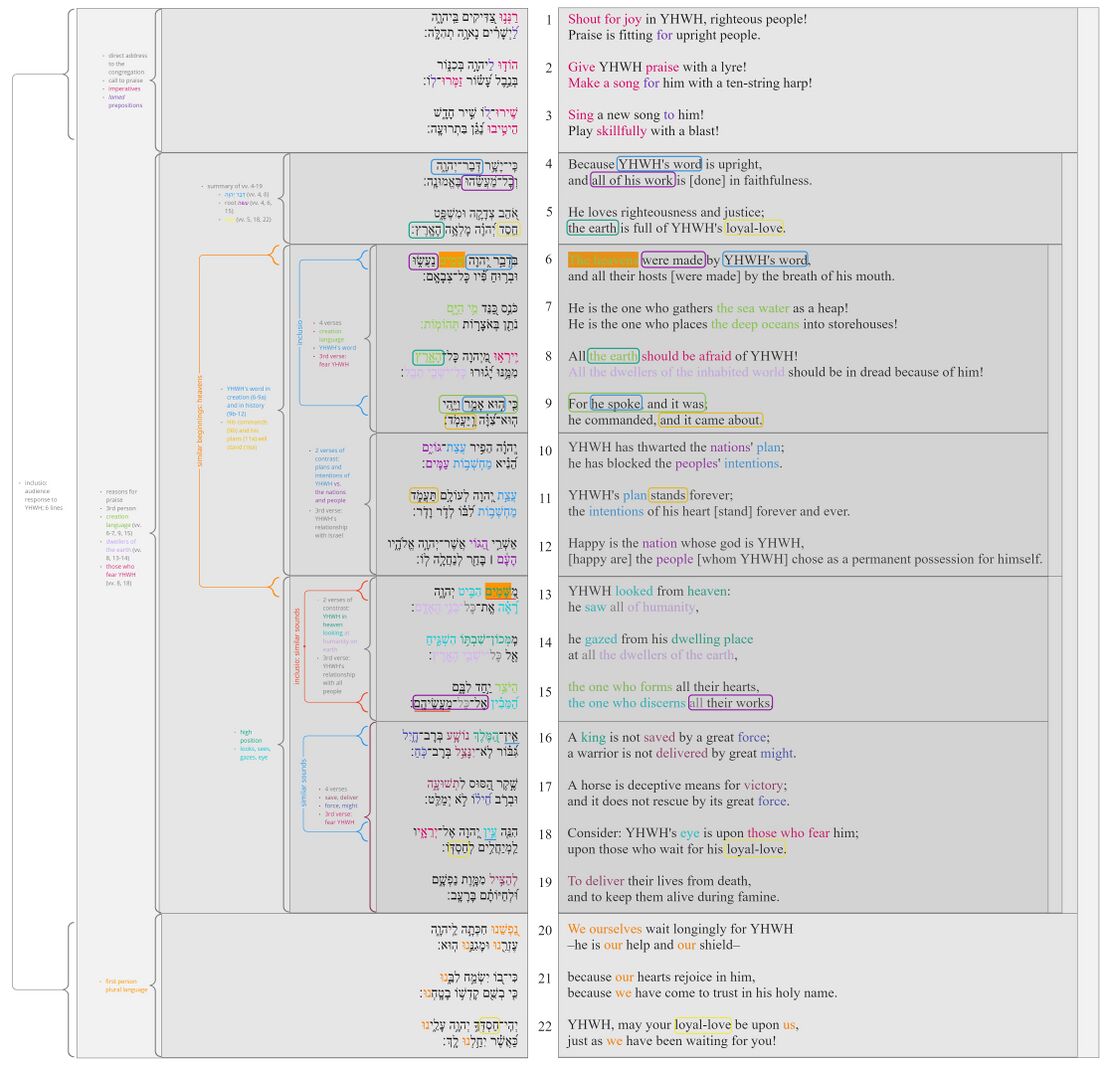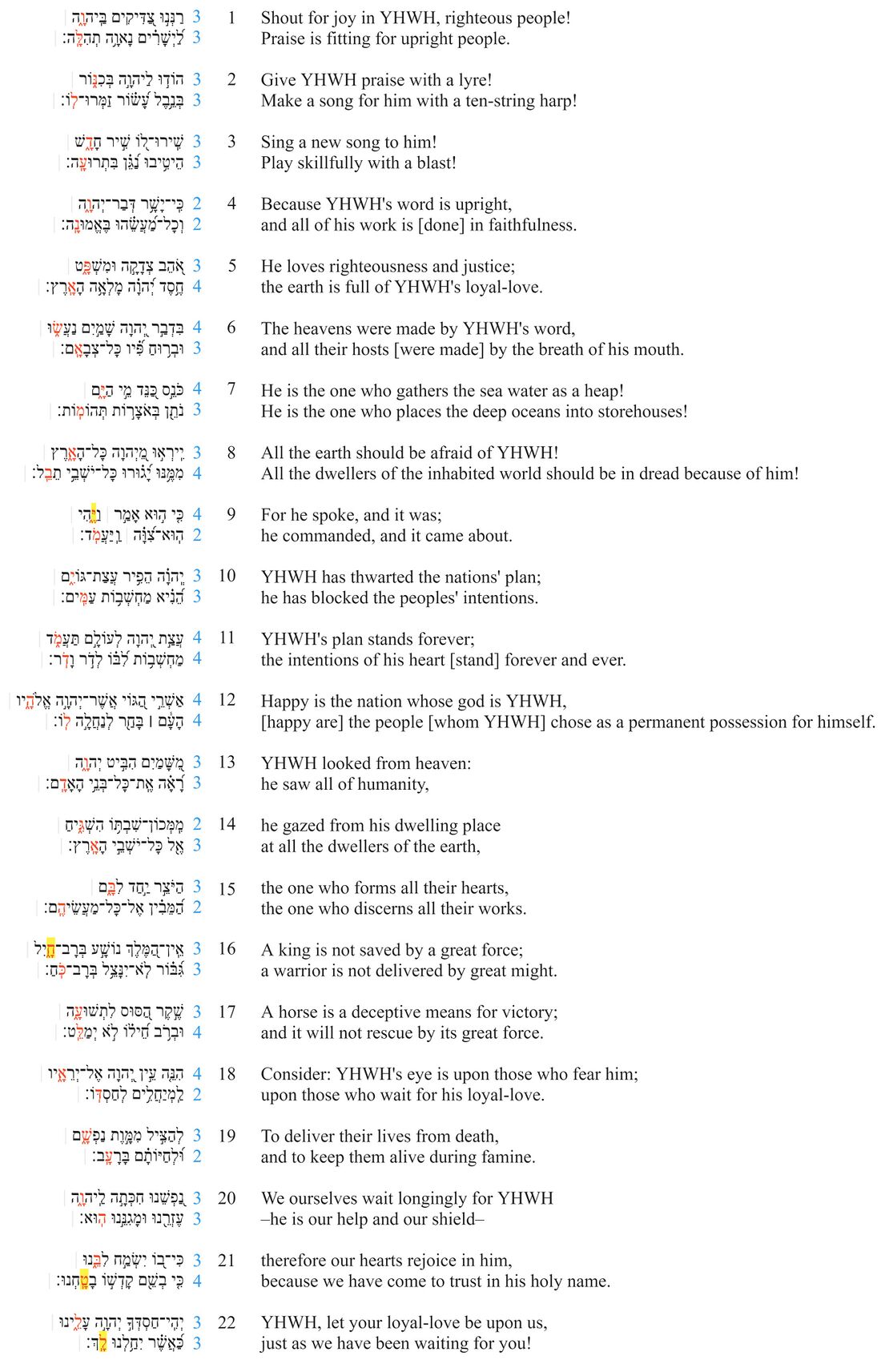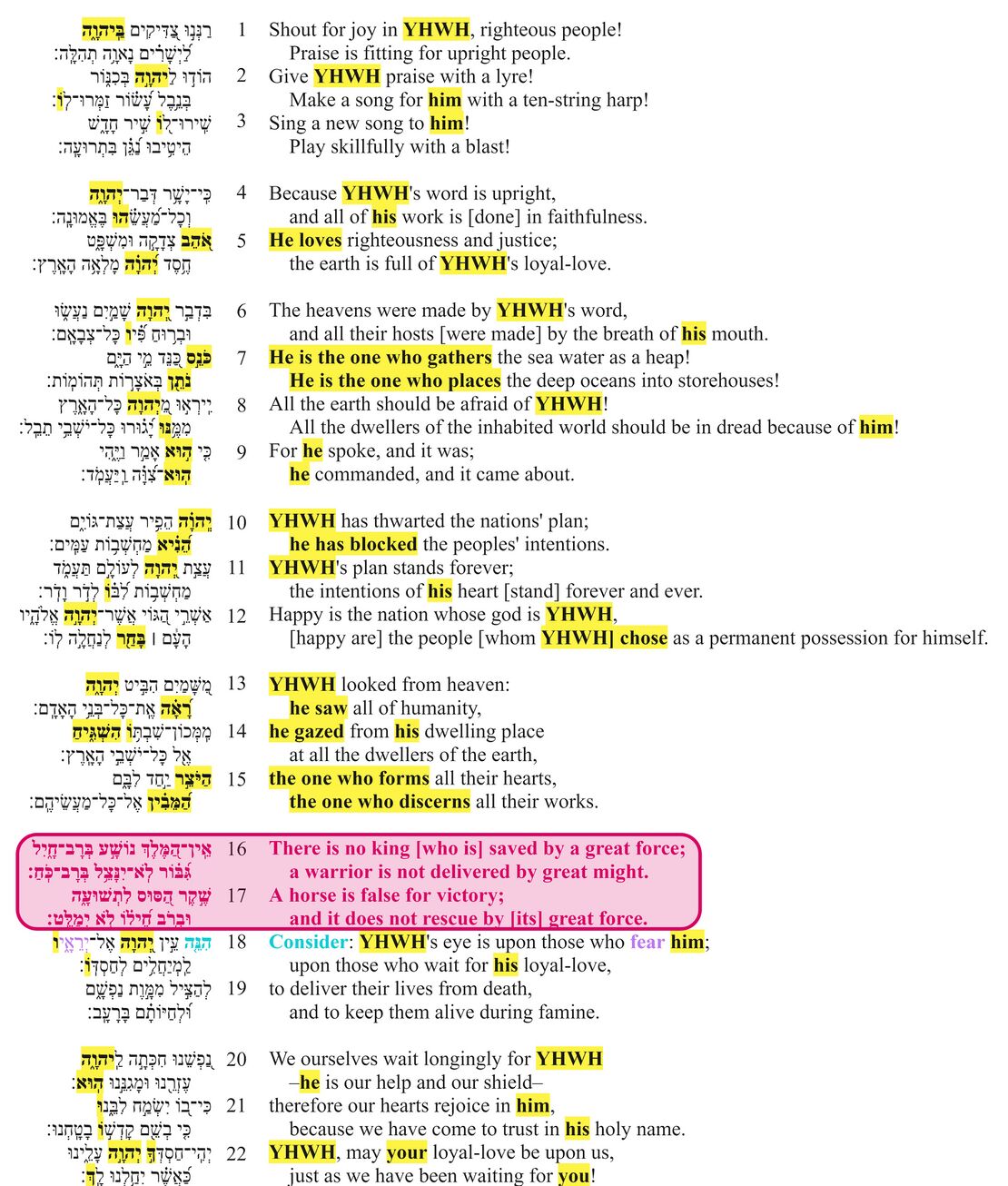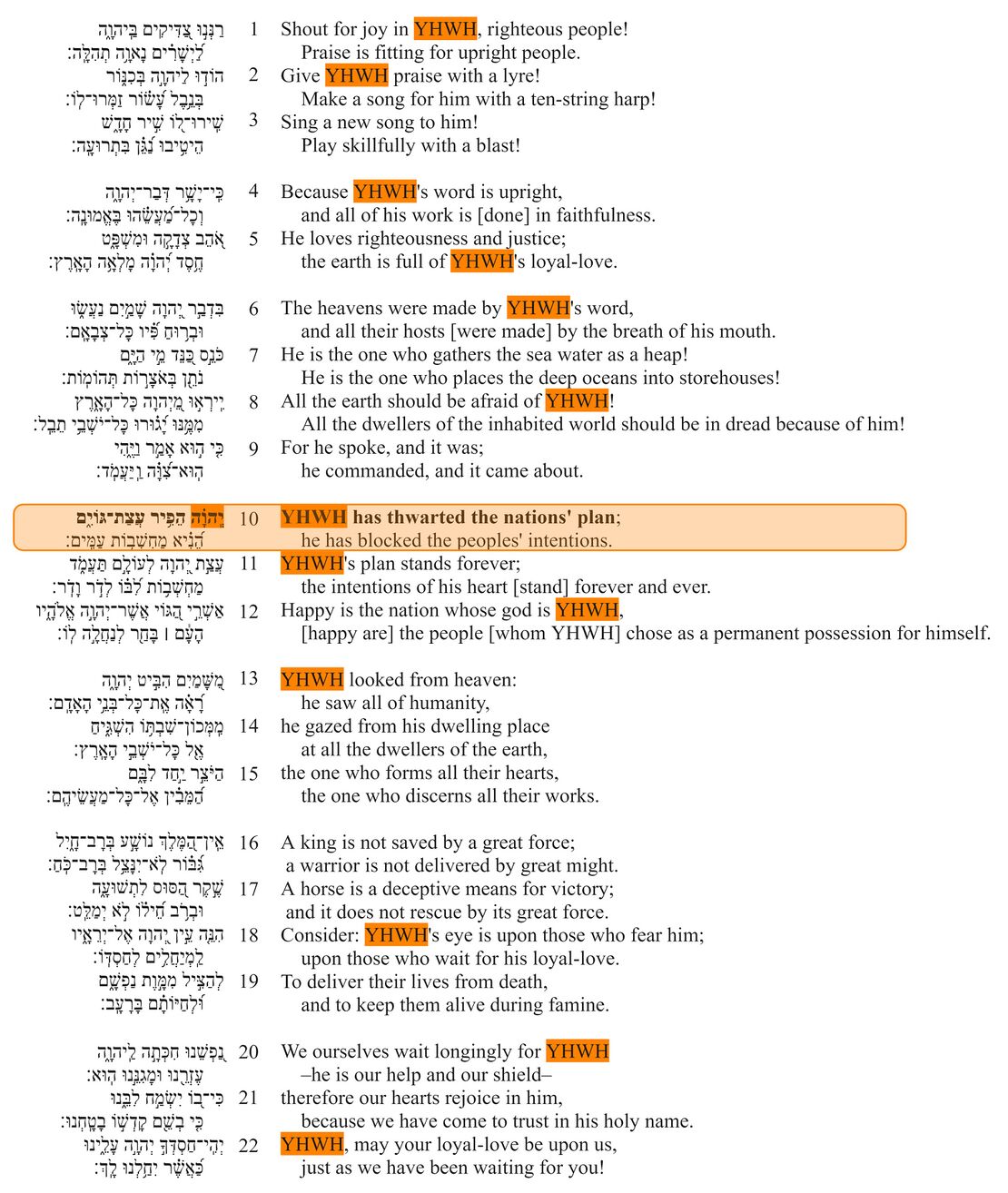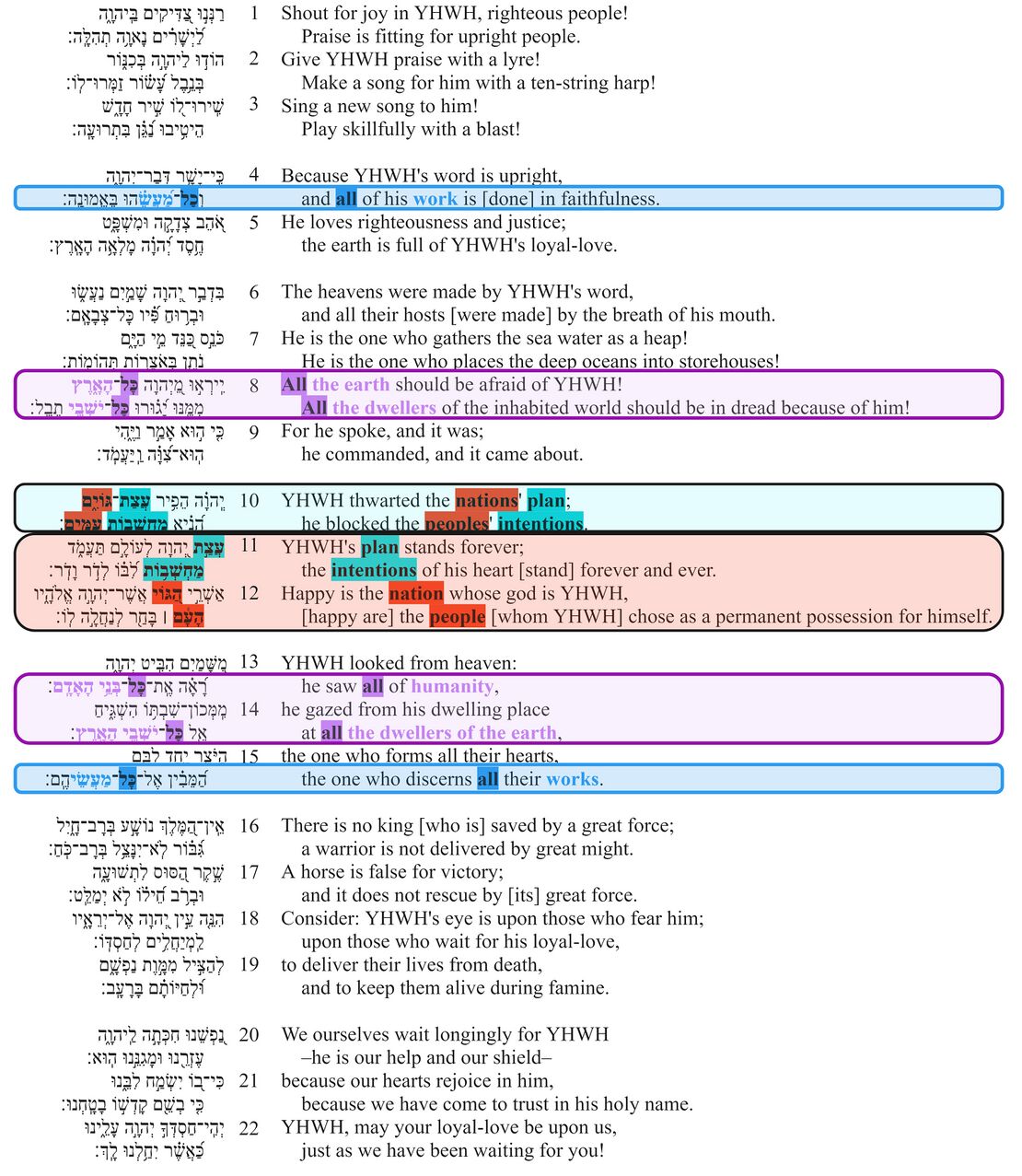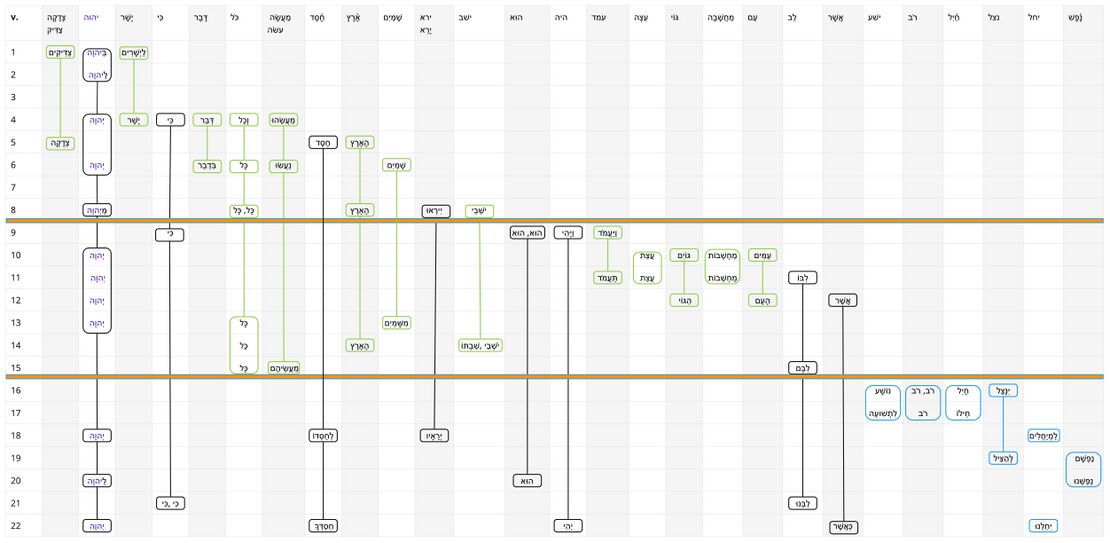Psalm 33 Poetry
About the Poetics Layer
Exploring the Psalms as poetry is crucial for understanding and experiencing the psalms and thus for faithfully translating them into another language. This layer is comprised of two main parts: Poetic Structure and Poetic Features.
Poetic Structure
In poetic structure, we analyse the structure of the psalm beginning at the most basic level of the structure: the line (also known as the “colon” or “hemistich”). Then, based on the perception of patterned similarities (and on the assumption that the whole psalm is structured hierarchically), we argue for the grouping of lines into verses, verses into strophes, strophes into stanzas, etc. Because patterned similarities might be of various kinds (syntactic, semantic, pragmatic, sonic) the analysis of poetic structure draws on all of the previous layers (especially the Discourse layer).
Poetic Features
Bibliography
- Aejmelaeus, Anneli. 1986. “Function and Interpretation of כי in Biblical Hebrew.” JBL 105: 193–209.
- ________. 1993. On the Trail of Septuagint Translators: Collected Essays. Kampen: Kok Pharos Pub. House.
- Anderson, A. A. 1972. The Book of Psalms Volume 1: Psalms 1-72. Grand Rapids: Eerdmans.
- Auffret, Pierre. 2009. "'Rendez Grace a YHWH Avec La Harpe': Etude Structurelle Du Psaume 33." Estudios Bíblicos 67: 85–100.
- Baethgen, Friedrich. 1904. Die Psalmen. Göttingen: Vandenhoeck und Ruprecht.
- Bekins, Peter. 2014. "Object Marking in Biblical Hebrew Poetry." SBLSPS 53. San Diego: Society of Biblical Literature.
- Berlin, Adele. 2007. The Dynamics of Biblical Parallelism. 2nd ed. Grand Rapids: Eerdmans.
- Blau, Joshua. 1976. A Grammar of Biblical Hebrew. Wiesbaden: Otto Harrassowitz.
- Boda, Mark J. 2010. 1-2 Chronicles. Cornerstone Biblical Commentary 5. Carol Stream, IL: Tyndale House Publishers.
- Bratcher, Robert G., and William D. Reyburn. 1991. A Handbook on Psalms. UBS Handbook Series. New York: United Bible Societies.
- Briggs, Charles A., and Emilie Grace Briggs. 1906. A Critical and Exegetical Commentary on the Book of Psalms. ICC. New York: C. Scribner’s Sons.
- Calvin, John. 1965. A Commentary on the Psalms. Edited by T.H.L. Parker. Translated by Arthur Golding. Vol. 1. London: Camelot Press.
- Craigie, Peter C. 1983. Psalms 1–50. WBC 19. Dallas: Word.
- Dahood, Mitchell. 1966. Psalms I: 1-50. AB. Garden City, NY: Doubleday.
- ________. 1966. “Vocative Lamedh in the Psalter.” VT 16, no. 3: 299–311.
- deClaissé-Walford, Nancy, Rolf A. Jacobson, and Beth LaNeel Tanner. 2014. The Book of Psalms. NICOT. Grand Rapids: Eerdmans.
- Deissler, Alfons. 1956. “Der Anthologische Charakter des Psalmes 33 (32).” Pages 225–33 in Mélanges Bibliques: Rédigés en L’Honneur de Andre Robert. Edited by Pierre Casetti et al. Paris: Bloud & Gay.
- Duhm, Bernhard. 1899. Die Psalmen. Kurzer Hand-Commentar Zum Alten Testament 14. Leipzig und Tübingen: Mohr (Paul Siebeck).
- Fokkelman, J.P. 2000. Major Poems of the Hebrew Bible: At the Interface of Prosody and Structural Analysis (Vol 2: 85 Psalms and Job 4–14). Vol. 2. Assen: Van Gorcum.
- Garr, W. Randall. 2004. “ןה.” Revue Biblique 111:321–44.
- Hallo, William W., and K. Lawson Younger, eds. 2003. The Context of Scripture: Canonical Compositions from the Biblical World. Vol. 1. Leiden ; Boston: Brill.
- Hallo, William W., and K. Lawson Younger, eds. 2000. The Context of Scripture: Monumental Inscriptions from the Biblical World. Vol. 2. Leiden ; Boston: Brill.
- Hendel, Ronald S. 1996. In the Margins of the Hebrew Verbal System: Situation, Tense, Aspect, Mood. Zeitschrift Für Althebraistik 9: 152–81.
- Huehnergard, John. 1983. “Asseverative *la and Hypothetical *lu/Law in Semitic.” Journal of the American Oriental Society, 103, no. 3: 569–93.
- Humbert, Paul. 1946. La Terou’a: Analyse d’un Rite Biblique. Neuchatel: Université de Neuchatel.
- Hupfeld, Hermann. 1868. Die Psalmen. Vol. 2. Gotha: Friedrich Andreas Perthes.
- Janzen, Waldemar. 1965. “’Ašrê in the Old Testament.” Harvard Theological Review 58:215–26.
- Keel, Othmar. 1997. The Symbolism of the Biblical World: Ancient Near Eastern Iconography and the Book of Psalms. Winona Lake, IN: Eisenbrauns.
- Keil, Carl Friedrich, and Franz Delitzsch. 1996. Commentary on the Old Testament. Peabody: Hendrickson.
- Kennicott, Benjamin. 1775. Vetus Testamentum Hebraicum Cum Variis Lectionibus. Oxford:Clarendon Press.
- Kim, Young Bok. 2023. “Hebrew Forms of Address: A Sociolinguistic Analysis.” Atlanta: SBL Press.
- Kirkpatrick, A. F., ed. 1902. The Book of Psalms. London: Cambridge University Press.
- Kittel, Rudolf. 1922. Die Psalmen. Leipzig: A. Deichertsche Verlagsbuchhandlung Dr. Werner Scholl.
- Kolyada, Yelena. 2013. A Compendium of Musical Instruments and Instrumental Terminology in the Bible. Translated by Yelena Kolyada and David Clark. Abingdon: Routledge.
- König, Ekkehard, and Peter Siemund. 2007. “Speech Act Distinctions in Grammar.” Pages 276–324 in Language Typology and Syntactic Description. Edited by Timothy Shopen. Vol. 1 of 3. Cambridge: Cambridge University Press.
- Kraus, Hans-Joachim. 1988. Psalms 1-59: A Commentary. Minneapolis: Augsburg.
- Kugel, James L. 1981. The Idea of Biblical Poetry: Parallelism and Its History. New Haven: Yale University Press.
- Labuschagne, C.J. 2020 “Numerical Features of the Psalms, a Logotechnical Quantitative Structural Analysis.” DataverseNL.
- Locatell, Christian. 2017. “Grammatical Polysemy in the Hebrew Bible: A Cognitive Linguistic Approach to כי.” PhD Dissertation, University of Stellenbosch.
- Locatell, Christian. 2019. “Causal Categories in Biblical Hebrew Discourse: A Cognitive Approach to Causal כי.” Journal of Northwest Semitic Languages 45, no. 2: 79–102.
- Lugt, Pieter van der. 2006. Cantos and Strophes in Biblical Hebrew Poetry: With Special Reference to the First Book of the Psalter. Vol. 1. Oudtestamentische Studiën 53. Leiden: Brill.
- Merrill, Eugene H. 2015. A Commentary on 1 & 2 Chronicles. Kregel Exegetical Library. Grand Rapids: Kregel Academic.
- Miller-Naudé, Cynthia L. 2010. “Vocative Syntax in Biblical Hebrew Prose and Poetry: A Preliminary Analysis.” Journal of Northwest Semitic Languages 36, no. 1: 43–64.
- Murray, Sarah. 2014. “Varieties of Update.” Semantics and Pragmatics 7:1–53.
- Muraoka, Takamitsu. 1985. Emphatic Words and Structures in Biblical Hebrew. Leiden: Brill.
- Niccacci, Alviero. 2006. “The Biblical Hebrew Verbal System in Poetry.” Pages 247–68 in Biblical Hebrew in Its Northwest Semitic Setting: Typological and Historical Perspectives. Edited by Steven E. Fassberg and Avi Hurvitz. Jerusalem: Hebrew University Magnes Press.
- O’Connor, Michael Patrick. 1980. Hebrew Verse Structure. Winona Lake, IN: Eisenbrauns.
- Podechard, Emmanuel. 1949. Le Psautier: notes critiques: Psaumes 1-75. Vol. 1. Bibliotèque de la Faculté Catholique de Théologie du Lyon 4. Lyon: Facultés Catholiques.
- Ross, Allen P. 2001. Introducing Biblical Hebrew. Grand Rapids: Baker Academic.
- ________. 2011. A Commentary on the Psalms, Volume 1: 1-41. Kregel Exegetical Library. Grand Rapids: Kregel Academic.
- Ryken, Leland, Jim Wilhoit, Tremper Longman, Colin Duriez, Douglas Penney, and Daniel G. Reid, eds. 1998. Dictionary of Biblical Imagery. Downers Grove, IL: InterVarsity Press.
- Stec, David M., ed. 2004. The Targum of Psalms. The Aramaic Bible 16. Collegeville, MN: Liturgical Press.
- Strickman, H. Norman. 2009. Rabbi Abraham Ibn Ezra's Commentary on the First Book of Psalms. Boston: Academic Studies Press.
- Suderman, W. Derek. May 2015. “The Vocative Lamed and Shifting Address in the Psalms: Reevaluating Dahood’s Proposal.” VT 65, no. 2: 297–312.
- Tate, Marvin E. 1998. Psalms 51–100. WBC 20. Dallas: Word.
- Taylor, Richard A. 2020. The Syriac Peshitta Bible with English Translation. Piscataway, NJ: Gorgias Press.
- Vincent, Jean Marcel. 1978. “Recherches Exégétiques Sur Le Psaume 33.” VT 28: 442–54.
- Witte, Markus. 2002. “Das Neue Lied--Beobachtungen Zum Zeitverständnis von Psalm 33” ZAW 114: 522–41.
- Ziegert, Carsten. 2020. “What Is חֶ֫סֶד? A Frame-Semantic Approach.” JSOT 44: 711–32.

